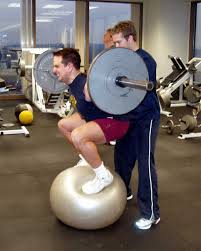 Here’s the really cool part…I have been lucky enough to have a mix of professional fighters, mountain bikers, professional hockey players, knee, hip and low back rehabilitation clients, obstacle course competitors, fat loss clients and everything in between.
Here’s the really cool part…I have been lucky enough to have a mix of professional fighters, mountain bikers, professional hockey players, knee, hip and low back rehabilitation clients, obstacle course competitors, fat loss clients and everything in between.
No, I’ll be honest. I’ve made some mistakes, but nothing too serious. To be crystal clear, it’s not like I’ve had anyone back squat on a swiss ball or throw punches on a BOSU.
Today I’m going to share with you five mistakes I have made over the last four years. Of course, there may be some slight exaggerations below, but hopefully you get the point!
Five Common Programming Mistakes
1. Not considering a client’s stress level.
If you are a trainer, you are pretty much a shrink too. As a trainer you develop relationships with your clients and often times they share what’s on their mind, good, bad or indifferent. Related to training or not.
If you find clients sharing information with you, it’s great that your clients trust you, but the information they provide (whether on purpose or not) should help us coaches mold their programs.
Here’s a quick example:
Joe is a CPA and works at an incredibly busy firm. It’s the middle of March, he’s working 12+ hours every day, the weather sucks and his commute is brutal.
He’s been spending so much time at the office lately that a good portion of his nutrition, if you can call it that, comes from candy bars, large amounts of caffeine, massive amounts of trail mix and beef jerky. (It’s ok, beef jerky is Paleo, right?) Joe is so beat that occasionally he pops a pill from his small stash of ephedrine he got from Cumberland farms 10 years ago.
Joe is stressed to the max. He reeks of cortisol and doesn’t have much left in the tank.
Now, you tell me, is it better to:
A. Have him try for a PR on “MURPH” because it’s today’s WOD…
or
B. Spend a bit of extra time addressing his tissue quality, cleaning up his movement patterns, getting in a good sweat and trying to undo all of his upper and lower cross syndromes.
The choice is yours!

2. Programming everyone the way you program your own training program.
You know the old saying:
“When you have a hammer, everything looks like a nail!”
If you love training with kettlebells, everyone needs swings and get-ups right?
That’s right, everyone. Even the jacked-up clients with sway back posture, multiple disc herniations, neural tension and awful shoulder flexion. They still need swings and get-ups, right? Wrong. Pretend someone took away your precious kettlebells. You need to be able to figure out how else you can train these people.
If you are a powerlifter, does everyone need to train with barbells? Have you found yourself rushing to get your clients to back squatting, forgetting that they’ve suffered from a compression fracture and live in lumbar hyper-extension all day? Again, think about it. Do they need to back squat or are there other priorities for this client?
3. Introducing jump training prior to strength training.
I’m not referring to young kids playing on swing sets and obstacle courses. I’m talking about the 14-year-old female basketball player who wants to do “plyometrics” because her coach told said it would help her jump higher.
 Let’s cut to the chase. Fourteen-year-old female athletes don’t need plyos. They need to master basic movement patterns. A steady dose of strength training, tons of core work, deceleration training and balance work will go a long way.
Let’s cut to the chase. Fourteen-year-old female athletes don’t need plyos. They need to master basic movement patterns. A steady dose of strength training, tons of core work, deceleration training and balance work will go a long way.
Think about it this way. If you have a client who cannot move through a movement pattern in a slow and controlled fashion, what makes you think that speeding through it is a good idea? Speed is not always a good thing, even when it comes to athletes. Speed can actually be another form of compensation!!
Over the last 10+ years, I’ve trained a lot of female athletes and I’ve seen less than ten athletes who were actually ready for jump training. The rest just needed to get strong first. 🙂
4. Not understanding adequate rest periods.
Energy system development is very popular these days. When performed with proper work-to-rest ratios, you can pretty much build an athlete who will never quit! When implemented poorly, you will likely end up with a sore, tired, and often times, sick, client.
 I know that puking in a training session is glorified these days, but I assure you it’s really not good if people are constantly vomiting in your gym. Besides, have you ever tried cleaning that up? It’s not fun at all.
I know that puking in a training session is glorified these days, but I assure you it’s really not good if people are constantly vomiting in your gym. Besides, have you ever tried cleaning that up? It’s not fun at all.
In all seriousness, lets look a real life example.
If your goal is to create a lightning-fast athlete, you need a game plan. For example, alactic power training is a max-effort task. If your goal is to have an athlete perform 4 sets of 40 yd sprints at max effort, you might need to reconsider your rest times in between sets. In this scenario, taking a minute off just won’t cut it! You might need to take 6-10 minutes in between sets so you can replicate your max effort performance.
Another energy system error I see is not using a heart rate monitor. Sure, you can get a basic idea of appropriate work-to-rest ideas via Sport Science templates, but using a monitor for recovery removes the guess-work.
5. Never trying your own programs.
We’ve all been guilty of this. It’s easy to write the best workout in the world for everyone, but yourself. If you are writing a brand new program that focuses on hypertrophy, shouldn’t you have tested it or at least part of it first?
If you are 5’3”, and weigh 125 (the same as you did in 8th grade) and want to tell me about your hidden secrets for hypertrophy and for sick gainz, I probably wont listen to you even if it’s good information. A simple suggestion is to follow your plan prior to marketing it.
A huge error I see these days is when it comes to glycolytic power training. In a nutshell, you are asking your athlete to perform a :30 all-out sprint on a bike, recover 2-3 minutes and do it a few times.
This sucks. No really, it’s terrible.
A :30 bike sprint can destroy your client and ruin their day. If you’ve everperformed one of these, you’ll agree with me. This is exactly why you need to understand how this type of training impacts your athletes. Even if you know it’s tough, put yourself through a few of these before you ask your client to do six of them in a single training session.
Side note: In addition to experiencing this kind of suck first-hand, you also need to progress your athletes up to a point before they are ready for glycolitic work.
Hopefully you learned something from the four mistakes I’ve made when designing programs for my clients. These weren’t my first mistakes and they certainly won’t be the last.
If you design programs for your clients, you should constantly be reading, learning, experimenting and tweaking how you approach training. Every day is an opportunity to get better!
I’ll leave you with two things…
1. Just because a training program works well for one client, doesn’t mean it will work well for everyone.
2. Just because a training program works well doesn’t mean it’s the best and/or the only way!
As always, train smart and train hard.
